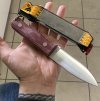Hi, thanks for all the help for those who post on this forum.
Goal: Looking for a fast, portable way to get a fairly consistent 20 degree edge on knives. I don't want to rely on skill with a whetstone or free handing anything. For this particular purpose, it's about spending the least amount of time and getting a fairly consistent edge. Just trying to keep various kitchen knives sharp. This is for a business use, that's why time is important. It's not a professional sharpening business,.
Would there be anything you recommend?
Thanks for your help.
Goal: Looking for a fast, portable way to get a fairly consistent 20 degree edge on knives. I don't want to rely on skill with a whetstone or free handing anything. For this particular purpose, it's about spending the least amount of time and getting a fairly consistent edge. Just trying to keep various kitchen knives sharp. This is for a business use, that's why time is important. It's not a professional sharpening business,.
Would there be anything you recommend?
Thanks for your help.


